While this article doesn’t deal specifically with garden tips, if you’d like to know more about plants that live in wet areas, please read Joe Whitfield’s article on wetland plants. You might be able to identify some of these plants when you are out in nature.
One question that gets asked is “How do I know I’m in a wetland area?” The easy answer is to just keep walking until the water leaks into you shoes. However, since no one wants to walk around in soggy shoes, an easy way is to observe the plants growing nearby.
There are two types of wetland plants: Obligate plants; these are plants that almost always grow in a wetland area, and Facultative plants; these are the plants that usually grow in wetland areas.
One of the easiest plants to spot and to remember is Cattails. These plants can grow up to seven feet tall. The seed head is the most recognizable part of the plant. It is a large, sausage-shaped seed head that turns brown when it matures. The leaves are flat and have no midrib. When young it can be confused for Irises or Sweetflag.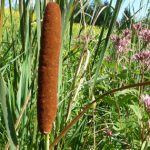
While the Cattail is an important plant for water birds, amphibians, fish and mammals, they will get out of hand of not controlled. Cattails can spread by both windborne seeds and rhizomes (underground roots). If you know what you are doing, quite a bit of the plant can be used for food.
Arrowhead is another common plant in wetlands. It has triangular arrow-like leaves; the flower has three petals and is white. This plant can get almost five feet tall. Arrowheads are a perennial plant with about 20 species native to the eastern U.S. These plants colonize well and will fill in shallow ponds and such; you can even grow them in a container of mud or wet kitty litter. Just remember to water it very well. It is also known called Duck Potato because the tubers are edible for muskrat, porcupines, and people (if you really have to). The seeds are 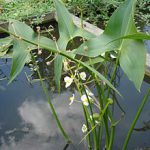 eaten by waterfowl.
eaten by waterfowl.
Yellow Marsh Marigold is misnamed; they are a member of the Buttercup family, not the Marigold family. The flowers of this plant look similar to other Buttercup plants, having five-petaled yellow flowers with large, very smooth and round leaves. 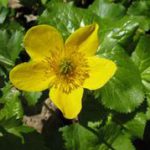 This is one of the earliest wildflowers to bloom. The bright yellow color is a welcome sight on wet, rainy days. It will get up to 18 inches tall and the leaves are heart-shaped. After it quits blooming the leaves can get up to 8 inches across. Look for Skunk Cabbage; where you find one, you’ll find the other.
This is one of the earliest wildflowers to bloom. The bright yellow color is a welcome sight on wet, rainy days. It will get up to 18 inches tall and the leaves are heart-shaped. After it quits blooming the leaves can get up to 8 inches across. Look for Skunk Cabbage; where you find one, you’ll find the other.
Jewel Weed (also known as Touch-me-not) has two types of  flowers. One is orange-spotted; the other one has pale yellow flowers. These plants get to about 5 feet tall. They are found usually in wetland areas but can be found other places. Once the seeds are ripe, if the flowers are touched, the seeds shoot out. If you ever get caught in Stinging nettles or Poison ivy, look around for one these plants. The crushed leaves and juice from the stem are a well-known remedy to ease the itching.
flowers. One is orange-spotted; the other one has pale yellow flowers. These plants get to about 5 feet tall. They are found usually in wetland areas but can be found other places. Once the seeds are ripe, if the flowers are touched, the seeds shoot out. If you ever get caught in Stinging nettles or Poison ivy, look around for one these plants. The crushed leaves and juice from the stem are a well-known remedy to ease the itching.
The Swamp Milkweed grows to a height of 5 feet and there are two types. One of them has small pink-purple flowers that you find in bogs and marshes. The other has white flowers and prefers shady wetlands. Butterflies and hummingbirds really love this plant.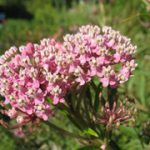
The Cardinal Flower is one of the prettiest plants you’ll find growing in the wetlands. It also gets up to 5 feet tall and has bright red flowers. It can grow either in the sun or the shade and hummingbirds are highly attracted to this plant. There has been an occasional attempt to get this flower named as the State flower. If you have a rain garden, this is a very showy flower to grow.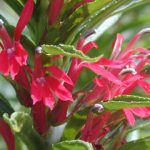
Queen-of-the-Prairie is a rather large plant; the rose-pink flower clusters can get up to 10 inches across and almost 12 inches long. The entire plant will get up to 6 feet tall. It grows in boggy areas and moist meadows. Once planted it will take over due to its creeping rhizomes.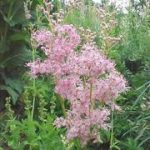
These are just a few of the wetland plants that can be found in the wild, or you can grow on your own.
Leave a Reply